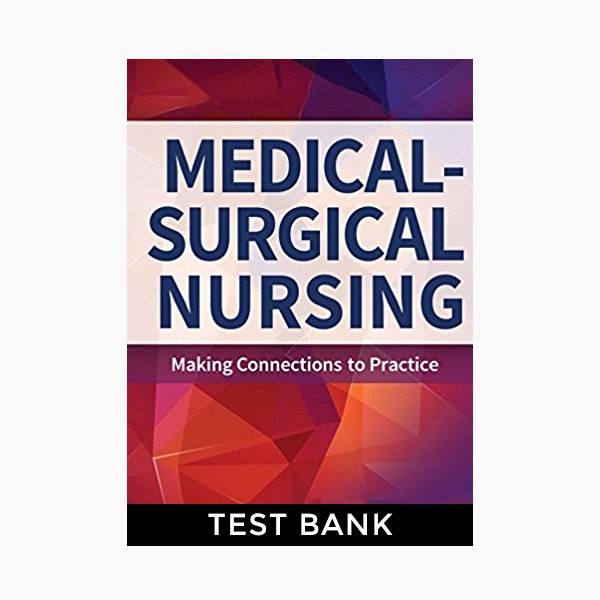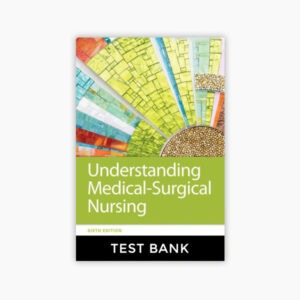Medical-Surgical Nursing: Making Connections to Practice, 1st Edition, Hoffman Sullivan Test Bank
I. Professional Foundations of Medical-Surgical Nursing
Chapter 1. Foundations for Medical-Surgical Nursing
Chapter 2. Interprofessional Collaboration and Care Coordination
Chapter 3. Cultural Considerations
Chapter 4. Ethical Concepts
Chapter 5. Palliative Care and End-of-Life Issues
II. Clinical Principles of Medical-Surgical Nursing
Chapter 6. Geriatric Implications for Medical-Surgical Nursing
Chapter 7. Oxygen Therapy Management
Chapter 8. Fluid and Electrolyte Management
Chapter 9. Acid-Base Balance
Chapter 10. Overview of Infusion Therapies
Chapter 11. Pain Management
Chapter 12. Complementary and Alternative Care Initiatives
Chapter 13. Overview of Cancer Care
Chapter 14. Overview of Shock and Sepsis
III. Managing the Surgical Experience
Chapter 15. Priorities for the Preoperative Patient
Chapter 16. Priorities for the Intraoperative Patient
Chapter 17. Priorities for the Postoperative Patient
IV. Promoting Health in Patients With Immune Disorders
Chapter 18. Assessment of Immune Function
Chapter 19. Coordinating Care for Patients With Connective Tissue Disorders
Chapter 20. Coordinating Care for Patients With Immune Disorders
Chapter 21. Coordinating Care for Patients With Multidrug-Resistant Organism Infectious Disorders
Chapter 22. Coordinating Care for Patients With HIV
V. Promoting Health in Patients With Oxygenation Disorders
Chapter 23. Assessment of Respiratory Function
Chapter 24. Coordinating Care for Patients With Infectious Respiratory Disorders
Chapter 25. Coordinating Care for Patients With Upper Airway Disorders
Chapter 26. Coordinating Care for Patients With Lower Airway Disorders
Chapter 27. Coordinating Care for Critically Ill Patients With Respiratory Dysfunction
VI. Promoting Health in Patients With Circulatory or Perfusion Disorders
Chapter 28. Assessment of Cardiovascular Function
Chapter 29. Coordinating Care for Patients With Cardiac Dysrhythmia
Chapter 30. Coordinating Care for Patients With Cardiac Disorders
Chapter 31. Coordinating Care for Patients With Vascular Disorders
Chapter 32. Coordinating Care for Critically Ill Patients With Cardiovascular Dysfunction
VII. Promoting Health in Patients With Hematological Disorders
Chapter 33. Assessment of Hematological Function
Chapter 34. Coordinating Care for Patients With Hematological Disorders
VIII. Promoting Health in Patients With Neurological Disorders
Chapter 35. Assessment of Neurological Function
Chapter 36. Coordinating Care for Patients With Brain Disorders
Chapter 37. Coordinating Care for Patients With Spinal Cord Disorders
Chapter 38. Coordinating Care for Patients With Peripheral Nervous System Disorders
Chapter 39. Coordinating Care for Critically Ill Patients With Neurological Dysfunction
IX. Promoting Health in Patients With Endocrine Disorders
Chapter 40. Assessment of Endocrine Function
Chapter 41. Coordinating Care for Patients With Pituitary Disorders
Chapter 42. Coordinating Care for Patients With Adrenal Disorders
Chapter 43. Coordinating Care for Patients With Thyroid and Parathyroid Disorders
Chapter 44. Coordinating Care for Patients With Diabetes Mellitus
X. Promoting Health in Patients With Sensory System Disorders
Chapter 45. Assessment of Visual Function
Chapter 46. Coordinating Care for Patients With Visual Disorders
Chapter 47. Assessment of Auditory Function
Chapter 48. Coordinating Care for Patients With Hearing Disorders
XI. Promoting Health in Patients With Integumentary Disorders
Chapter 49. Assessment of Integumentary Function
Chapter 50. Coordinating Care for Patients With Skin Disorders
Chapter 51. Coordinating Care for Patients With Burns
XII. Promoting Health in Patients With Musculoskeletal Disorders
Chapter 52. Assessment of Musculoskeletal Function
Chapter 53. Coordinating Care for Patients With Musculoskeletal Disorders
Chapter 54. Coordinating Care for Patients With Musculoskeletal Trauma
XIII. Promoting Health in Patients With Gastrointestinal Disorders
Chapter 55. Assessment of Gastrointestinal Function
Chapter 56. Coordinating Care for Patients With Oral and Esophageal Disorders
Chapter 57. Coordinating Care for Patients With Stomach Disorders
Chapter 58. Coordinating Care for Patients With Intestinal Disorders
Chapter 59. Coordinating Care for Patients With Hepatic Disorders
Chapter 60. Coordinating Care for Patients With Biliary and Pancreatic Disorders
XIV. Promoting Health in Patients With Renal Disorders
Chapter 61. Assessment of Renal and Urinary Function
Chapter 62. Coordinating Care for Patients With Renal Disorders
Chapter 63. Coordinating Care for Patients With Urinary Disorders
XV. Promoting Health in Patients With Reproductive Disorders
Chapter 64. Assessment of Reproductive Function
Chapter 65. Coordinating Care for Female Patients With Reproductive and Breast Disorders
Chapter 66. Coordinating Care for Male Patients With Reproductive and Breast Disorders
Chapter 67. Coordinating Care for Patients With Sexually Transmitted Infection
XVI. Promoting Health in Special Populations
Chapter 68. Managing Care for the Adult Patient With Obesity
Chapter 69. Substance Use Disorders in the Adult Population
Chapter 70. Emergency, Trauma, and Environmental Injuries
Chapter 71. Mass Casualty and Disaster Preparedness




















Reviews
There are no reviews yet.